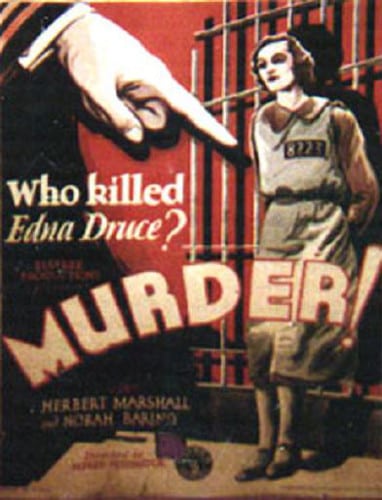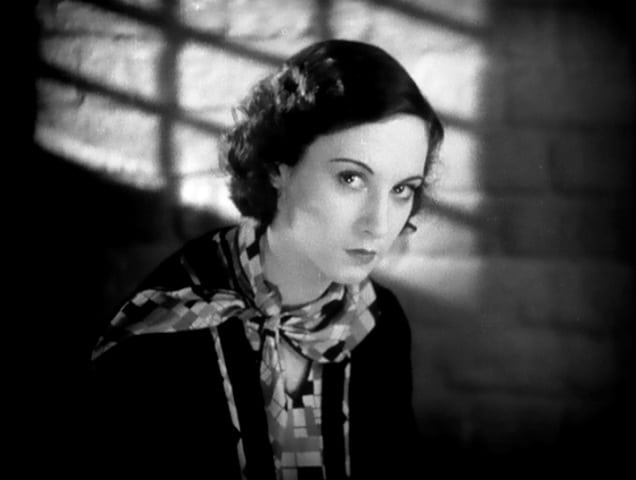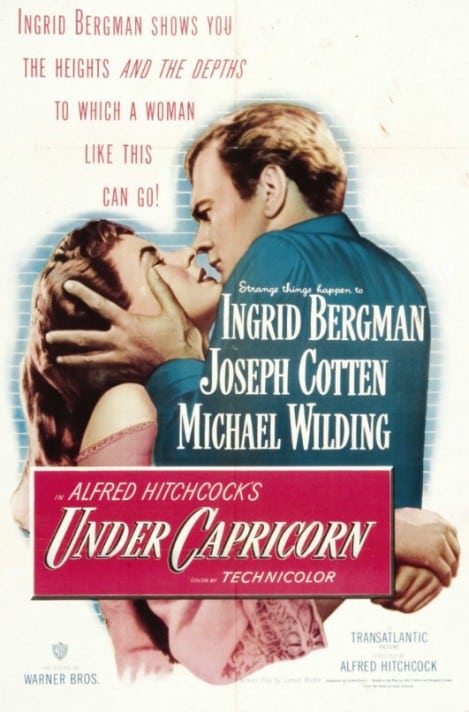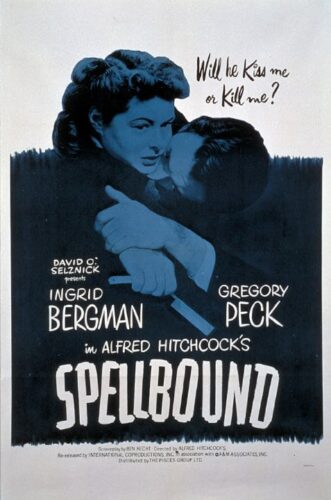Murder! (1930)
Directed by: Alfred Hitchcock
Written by: Alfred Hitchcock, Alma Reville, Helen Simpson, Walter Mycroft
Starring: Edward Chapman, Herbert Marshall, Norah Baring, Phyllis Constan
UK
AVAILABLE ON DVD
RUNNING TIME: 96 min
THE HITCHCOCK CAMEO: Walking past the house where the murder was committed, with a female companion
REVIEWED BY: Dr Lenera, Official HCF Critic
In her flat one evening, Diana Baring is found hovering over the murdered body of Edna Druce. Diana’s dress is bloodied, and the murder weapon, a fireplace poker, is sitting at her feet. Both women are actresses in Edna’s husband’s theatre company. Those who know the two know that they did not like each other. Diana says she doesn’t remember anything about the murder. She is tried and, when all the jurors come round to the same conclusion, convicted of murder. After the trial, one of the jurors, Sir John Menier, has second thoughts as to Diana’s guilt. A renowned actor with a theatre company of his own, Sir John has a few pieces of information concerning the case nagging on his mind, and sets to investigate……
Murder! Is Hitchcock’s first fully-fledged sound motion picture if you don’t count the revue Elstree Calling. As you might expect, it’s rather stiff and moves at quite a slow pace, with the cast not helping by pausing after most of their lines of dialogue. You could probably edit the dialogue scenes without losing any words and speed the pace up a little. It’s a ‘whodunnit’, generally not something Hitchcock was interested in much as he preferred suspense over surprise. As such, it works reasonably well and certainly has some points of interest including some quite shocking racism which would cause an outcry now, while Hitchcock employs as many directorial flourishes as he can cram in to enhance the story as well as to purely show off! It’s not a classic, but this extremely talky, dated but intriguing film just about holds the attention so long as you don’t expect knife-edge suspense.
This film was based on a novel called Enter St John by Clemence and Helen Simpson. Cast and crew consisted largely of people Hitchcock had worked with before; by now, he had amassed what was virtually a repertory company. He tried to experiment with improvised dialogue to make things feel spontaneous, with cast members being told the nature of the things they should be saying, then being left to make up their actual dialogue as they went along. The results felt flat and little of this remains in the finished film, while Hitchcock never tried this kind of thing again. As sometimes happened at the time with both British and American films, the director had to shoot two versions of Murder! at the same time, the second one being a German-language version called Mary. Hitchcock refused most of the alterations that were suggested to him, but later regretted this as they were only intended to make the film more relatable for German audiences and may have made it a bigger success in Germany. Elsewhere Murder! was genrally a critical and commercial hit though in the US it lost twelve minutes to tighten things up. Some of the jury deliberations and Sir John staying at the rooming house were lost; the latter not only removed Una O’ Connor’s role as the landlady but a bit of information important to the eventual solving of the mystery.
Murder! certainly opens in great fashion, the camera tracking along the rooms in the boarding house where the murder has just taken place, showing through the windows people scrambling into their clothes [including an amusing bit inspired by a childhood memory of Hitchcock’s mother where she struggled to get two legs into one knicker] and looking out to see what is going on. Soon after that there is a great slow pan in the victim’s room to the body, but then the film becomes almost a precursor to the classic Twelve Angry Men as we speed through the trial at rapid speed and concentrate on the jury deliberations as they try to reach a verdict. There are some nice bits of characterisation here, from the guy who just doesn’t want to be a part of causing someone’s death to the guy who is absurdly laid back about it all. We don’t meet our ‘hero’ until twenty minutes in, and he isn’t sure that Diana is guilty but is soon swayed, the sounds of everyone else trying to convince him blurring into a mass of sound. This whole sequence is very long and Hitchock would probably normally have trimmed it, but it’s certainly very well acted by pretty much everyone in it.
The story really does seem to take forever to get into gear afterwards, with scenes like Sir John realising he has made a mistake going on for too long without being of much interest. However, said scene is of interest because it has cinema’s first ever voiceover to show someone’s thoughts, though it’s somewhat incongruously backed up by Richard Wagner’s intensely romantic Tristan und Isolde Prelude playing on the radio – this by the way was harder to do then one might think back then; they actually had to have an orchestra play the piece live but from a distance to give the impression the music was coming from a radio. We do eventually get to the investigation where interest mounts up considerably and leads to a really clever and tense, if rather contrived scene where, inspired by Hamlet, they get the killer to read for a part in a play based on the murder hoping he will confess. Most modern viewers will still be in shock at the revelation a bit earlier that he killed because he didn’t want the knowledge that he is a ‘half-caste’ to get out. John’s horrified cry of “black blood!” really leaves a sour taste in the mouth, though in the book it is quite clear that his ‘shame’ refers to the Indian caste system, one of his parents being an ‘untouchable’, rather than anything Negroid. The person in question is obviously homosexual too as played in a very effeminate manner by Esme Percy, and Francois Truffaut in his book interview with Hitchcock says it’s actually about that, but they couldn’t say it because of the censors. In any case, the character is given some sympathy when his stress causes his own death.
The duller parts of Murder! usually have some nice touches which range from subtle class humour to downright oddness, sometimes mixing the two like when, in the interminable section where John ‘recruits’ two aides from the theatre, a carpet in John’s big house seems like quicksand to the lowly working-class visitors. In a film which makes much of the distinction between real-life and the stage and how the two can intertwine, Hitchcock has some fun in some scenes with the backstage setting [which he would return to in Stage Fright], especially when he shows some of a play from the side. And he often slyly refuses to show us what we want to see, from the reading out of the juror’s verdict off-screen while an official clears the table in the juror’s room, to the total lack of an on-screen murder despite the title of the film. The scenes in Diana’s prison cell are shot in a totally unsubtle expressionistic manner, all Gothic shadows and even the image of a noose getting bigger and bigger. Norah Baring is an actress who seemed to fade into obscurity and whom few have heard of, but she’s quite a stunner going by this film and her rather moving performance helps make her side of the film’s story [Hitchcock’s second wrongfully accused person!] work rather well.
Murder! has an early starring role for Herbert Marshall, a somewhat under-appreciated star today, but whose smooth voice and knack for communicating silently with his facial muscles made many female stars especially request him as a leading man. That quality is already in evidence in this film. It’s not a major work in the context of later masterpieces truth be told, and you could probably fast-forward a few bits of it without much loss, but it’s intriguing all the same and perhaps a little darker and even deeper than it may first seem. The slightly twisted ending has Hitchcock almost breaking the fourth wall, as the camera zooms out from the closing shot to reveal that it is taking place on a stage before a large audience, and is obviously John’s play of the murder. Not only that, but poor Diana is the star, and therefore has to re-live her experience evening after evening!










Be the first to comment